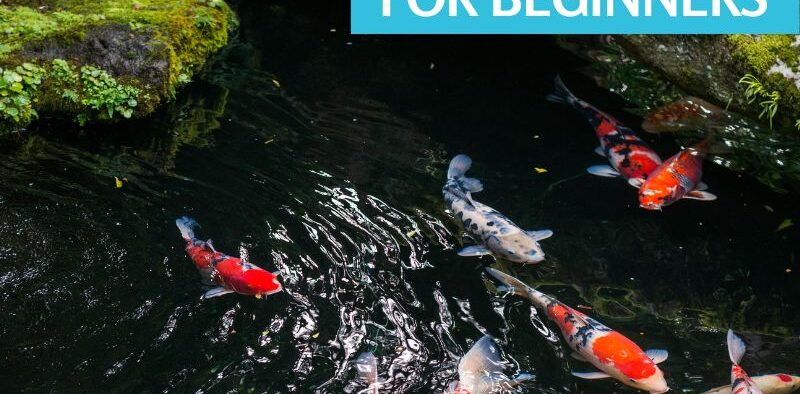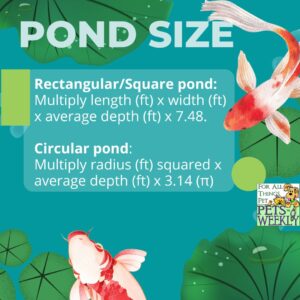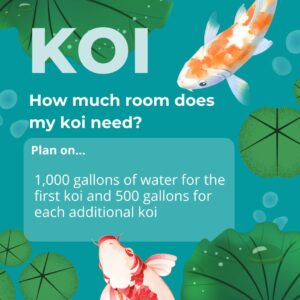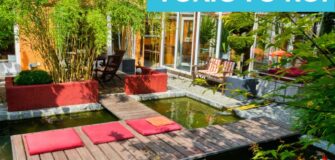Koi Pond Planning for Beginners
Share

Have you ever thought about putting a koi pond in your backyard? Well, we recently made the journey ourselves and we can’t wait to share our beautiful koi pond with you!That’s why we wrote what we hope will be a series of articles about koi pond planning for beginners.
I’m sure you’ve all been mesmerized by the vibrant colors and graceful movements of koi. These captivating fish, known for their longevity and symbolism of good luck, are more than just stunning additions to your garden. They offer a unique opportunity to create a tranquil oasis in your own backyard, fostering a connection with nature and providing hours of peaceful enjoyment.
But where do you begin if you’re a new koi owner, eager to embark on this exciting journey? Over the next few weeks, we’ll be guiding you along the “actual” process of installing a koi pond! Bear in mind, you will still need to do lots of research for success, but this guide will equip you with the essential knowledge to transform your dream into a thriving pond paradise for your koi.
1. Pond Preparation: Building the Foundation of Your Paradise
First things first, you need to plan on having a suitable pond. While pre-formed ponds offer convenience, consider a custom-built option for greater flexibility and depth. Remember, koi fish can grow quite large, so aim for a minimum depth of 3-4 feet and a surface area of at least 1,000 square feet to provide ample swimming space.
While you’re planning your koi pond, consider the number of koi fish you might want to have during the planning stage. There are a few different rules of thumb for giving enough space to koi fish, and the ideal amount of space will depend on a few factors, including:
Here are a few specific recommendations for the amount of space to allow for koi fish:
- For a small pond with 2-3 koi, you will need a minimum of 1000 gallons of water.
- For a medium pond with 4-6 koi, you will need a minimum of 2000 gallons of water.
- For a large pond with 7-10 koi, you will need a minimum of 3000 gallons of water.
It is important to remember that these are just general guidelines, and the best way to determine how much space your koi need is to consult with a qualified fish expert. They can take into account all of the specific factors involved in your situation and help you to create a healthy and happy home for your fish.
You will also need to consider depth. If you’re in an area that is very hot or very cold, you will need a depth of at least 4′ and probably areas that exceed 5-6′ in depth.
Finally, this is the one piece of information we can’t emphasize enough:
Ditch the thin liners from major hardware stores and splurge for a liner that will last!
At the very least, your liner should be at least 20 mil. However, if you have dogs who love to get into the koi pond, you should consider what we used which is a very durable Firestone liner that is 45 mil (which equates to about .045 inch-thick – or 1.14 mm). Make sure your liner is made from EDPM rubber or PVC material that is safe for fish and pets. Don’t skimp at this part of your planning. You’ll thank me later!
You will also need to add a geotextile liner that goes underneath the liner. This helps to protect the liner from sharp rocks and other objects that may eventually cause a leak in your pond. This is an important part of planning. You don’t want to spring a link later on!
2. Planning Your Koi Pond: Filtration, Aeration, and Circulation
Likely the most costly (and most important) part of your pond is planning the proper filtration, aeration, and circulation to maintain pristine water quality. These items are all essential for your koi pond’s health, as well as your koi’s health. Creating a thriving koi pond requires careful selection of equipment, especially for aeration and water movement. We will be discussing each of these in future articles. However, here’s a very quick breakdown to help you choose the right pond equipment.
Koi Pond Pump and Filter
Koi have very high oxygen demands. Choose an air pump that can turn over your pond’s entire volume every two hours. To do this, you will need to determine the pump’s flow rate, which is the amount of water it can move per hour. Here’s how to use your pond’s dimensions to:
How to Calculate Your Pond’s Volume
- Rectangular/Square pond: Multiply length (ft) x width (ft) x average depth (ft) x 7.48.
- Circular pond: Multiply radius (ft) squared x average depth (ft) x 3.14 (π).
- Determine the desired turnover rate: Aim for a pump that can circulate the entire volume of your pond at least once per hour. Ideally, for koi ponds, a turnover rate of twice per hour is recommended.
- Multiply your pond volume by the desired turnover rate: This will give you the minimum required flow rate for your pump in gallons per hour (GPH).
Example:
- Your pond is rectangular, measuring 10 ft long, 6 ft wide, and has an average depth of 3 ft.
- Volume = 10 ft x 6 ft x 3 ft x 7.48 = 1,496 gallons
- You desire a turnover rate of twice per hour (2).
- Minimum required flow rate = 1,496 gallons x 2 = 2,992 GPH

You will also need to consider these factors:
- Pond size: Larger ponds need stronger pumps.
- Depth: Deeper ponds require more powerful pumps to reach the bottom.
- Fish load: More fish means a greater oxygen demand, so adjust pump size accordingly.
- Water features: Factor in the flow rate needed for fountains or waterfalls.
- Filtration system: Ensure the pump’s capacity matches your chosen filter’s requirements.
Additional Pond Equipment You Will Need:
- Diffusers/Aerators: These release air bubbles efficiently, maximizing oxygen transfer.
- Skimmers: These remove debris from the water surface, improving water quality.
- Ultraviolet clarifiers: These combat algae growth by eliminating suspended algae cells.
Remember to do a lot of research. We loved the immense number of in-depth resources available at The Pond Guy.
- Consult a professional: They can help you determine the exact equipment needs for your unique pond setup. If you’re not good at plumbing, this is the best way to go – especially if you add a waterfall feature.
- Energy efficiency: Look for equipment with low wattage to save on electricity costs. Running a pond can get expensive.
- Durability: Choose equipment made from weather-resistant materials for long-lasting performance. This is especially important if you live in an area with extreme weather.
By carefully selecting the right equipment, you can ensure your koi pond provides a healthy and vibrant environment for your new fish.
3. Creating a Thriving Ecosystem: Plants and Substrate
Plants play a crucial role in your koi pond, providing oxygen, shade, food and hiding spots for your fish. Choosing the perfect plants can be challenging. You need to ensure they won’t take over your pond (like our ever pervasive edible watercress) or poison your koi (like water hemlock and many others).
Choose aquatic plants suitable for your region’s climate and your pond’s water depth. This helps ensure a balance between submerged and emergent varieties.
There is a big debate in the world of koi about whether to use a substrate like gravel, rocks, sand or nothing at all. This is largely a personal decision. You do need to understand that having any type of substrate can result in excess algae and make cleaning almost impossible.
Don’t forget beneficial bacteria! Introduce them through pond starter kits or by transferring water from an established pond to jump-start your pond’s natural ecosystem.
4. Choosing Your Koi Companions: Selecting the Perfect Fish
Even after you build your pond, you will need to wait for several weeks (or even better, months) before adding fish. The water needs plenty of time to cycle out and become healthy. But, you can start thinking about which species you want to add while you wait!
With a diverse array of varieties, choosing your koi can be overwhelming! Start by researching popular breeds like Kohaku, Showa, and Shashi. Each type of koi boasts distinct color patterns and most importantly, distinct personalities.
- The number of fish: As a general rule, you should allow 1000 gallons of water for the first koi and 500 gallons for each additional koi.
- The size of the fish: Larger koi will need more space than smaller koi.
- The filtration system: A good filtration system can help to support a higher number of fish in a smaller pond.
- The climate: Koi are coldwater fish, but they can still suffer from stress in very hot weather. If you live in a hot climate, you will need to provide your koi with a pond that is deep enough to stay cool in the summer.
Consider factors like size, compatibility with other fish, and your personal preferences. Always opt for healthy fish with vibrant colors and active movement. We found a wonderful koi breeder in Arizona. It’s a great way to start out with fish that are already acclimated, affordable and healthy.

5. Feeding for Health and Happiness: A Balanced Diet for Your Koi
Koi thrive on a varied diet that includes high-quality pellets, flakes, and frozen foods. Supplement their diet with fresh vegetables like lettuce and spinach for added nutrients. Remember, overfeeding can harm your fish and pollute the water, so practice moderation and observe their feeding habits.
You will need to consider a different form of nutrition during different times of the year. We will be discussing the feeding habits and how to train your koi soon!
6. Enjoying the Journey: Building a Bond with Your Aquatic Friends
Koi are surprisingly intelligent fish! With patience and gentle interactions, you can hand-feed them and even teach them simple tricks. Observing their behavior and enjoying their graceful movements is a rewarding experience that adds a unique dimension to your outdoor space.
Remember, this is just the beginning! As you embark on your koi journey, remember that research and proper care are key. Numerous online resources, experienced pond owners, and local fish clubs can offer valuable guidance. With dedication and a love for these magnificent creatures, you can create a thriving pond paradise that brings years of joy and tranquility to your life.








